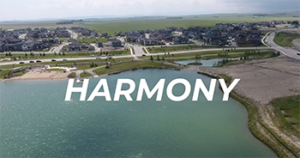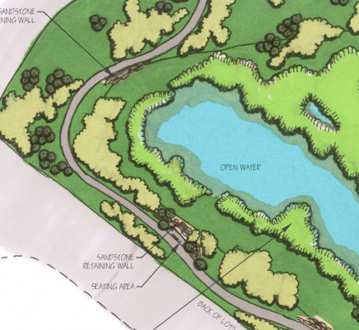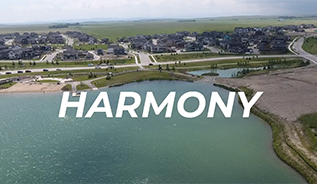In a market that is seeing continual growth and development, tackling the demands on the water systems in and around Calgary is no small task. So, it should come as no surprise that over the past five years, the team focused on our water practice in Calgary has expanded to include some incredibly talented consultants, bringing with them a varied set of skills to meet the needs presented with the sustained level of development. Every project is a team effort in Calgary, combining the talents and expertise of each member of our team which includes: Liliana Bozic, Leigh Chmilar, Brier Reid, Jenna Majkut, Taylor Swailes, and Yury Dobronravov.
So what exactly does the water practice do? To get a better sense of the impact they’re having in their communities, the team highlighted four projects that are directly linked to managing and mitigating the effects of development and growth throughout the region.
Harmony, AB: Making Sure Not a Drop is Wasted
 Our relationship with Harmony, AB, has been long-standing, and bringing the aspirations of this sustainable community to life has taken the efforts of countless consultants across a number of practice areas including community planning, land development, landscape architecture and transportation. The water practice team has also been heavily involved in the development, preparing a unique water management strategy for the 3,500 homes that make up the community.
Our relationship with Harmony, AB, has been long-standing, and bringing the aspirations of this sustainable community to life has taken the efforts of countless consultants across a number of practice areas including community planning, land development, landscape architecture and transportation. The water practice team has also been heavily involved in the development, preparing a unique water management strategy for the 3,500 homes that make up the community.
In any development, but especially one of this scale, the impact to the natural environment is an extremely important consideration. Stormwater runoff, for instance, is always a challenge for large developments, and the team, which includes Ariane and Leigh identified that the demands on water in the community would benefit from recycling that water to supply the residents. By diverting stormwater to a newly created wetland and the nearby lake, it is treated naturally through ozonation, recirculation and lake stratification, becoming a potable water source for the community. As for the effluent water not suitable for consumption, that becomes the water source for irrigation at the local golf course, limiting strain on the water supply for the residents of Harmony.
A year and a half into operation, the system is being monitored to collect data and adjust for future design as the need is identified. In the meantime, the project itself is being used as a model for what is possible in other communities and challenging the status quo. On top of this, due to a lack of established criteria and standards, Ariane, Leigh and the larger practice team collaborated closely with local government officials to define what those criteria were, and their work in Harmony has helped provide a living case-study that gives them the confidence needed for help further decision-making. It also means that they now have the unique opportunity to provide feedback to local and provincial government officials on the documents that will guide the solutions to many issues around water use and development standards.
James Walker Trail: Future-Proofing the Water Systems
How does an existing community plan ahead to meet the expected demands on road infrastructure and housing? For the Town of Cochrane, as the area of South Cochrane continues to expand, the need to build a better link to the town centre as well as an alternative route to Highway 1 has been proposed – namely, James Walker Trail. To be completed in two stages, one of which includes the construction of a bridge connection over the Bow River that divides the Town, the arterial will address the current needs as well as any anticipated future growth.
The water team, comprised of Ariane and Liliana as Stormwater Engineers, Leigh as Utility Servicing Advisor, were responsible for developing an evaporation pond and stormwater wetland to manage increased runoff from this new road and reduce the impact to the adjacent natural environment. The evaporation pond acts as water storage following a storm event, allowing water to simply evaporate in the sun or into the ground while mitigating flood risk, and the wetland allows for water to collect as a natural pond, facilitating plant life and maintenance of the natural landscape.
In anticipation of future developments east of the Trail, the bridge over the Bow River has also been pre-serviced with a water and sanitary pipes so that when the time comes, they are prepared to supply the new area of the community with utility services. Combined with the pond and wetland, the community is prepared to manage the inevitable changes to not only the established natural water flows, but also the increasing demands on services over time, limiting the unexpected and future-proofing their success.
Priddis Slough Wetland Management Plan: Protecting the Natural Environment While Supporting Growth
Establishing new ponds and wetlands are becoming essential resources for water management in newly developed areas, but what about when those natural wetlands that already exist around proposed construction areas? Protecting and sustaining the functions of those naturally formed water sources is integral to maintaining the biodiversity of local watersheds.
Priddis Slough sits at the south end of the City of Calgary, and at approximately 107 hectares, the wetland supports a diverse range of vegetation and wildlife habitats. Directly adjacent to it, the lands are facing increased development pressure. In order to mitigate risk to the health of the wetland, the City brought in Stormwater Engineers Liliana and Brier to prepare a Wetland Management Plan (WMP) in collaboration with wetland experts from Native Plant Solutions. The purpose of the WMP is to preserve the health and biophysical function of Priddis Slough, while its catchment changes to full urban development.
The team undertook a health assessment of the wetland, during which biologists anecdotally referred to its diversity of habitat, vegetation and overall health as “magnificent” despite the existing development. However, that clean bill of health is not a guarantee when the catchment is fully developed, and if the WMP is not implemented, the wetland would gradually lose its biodiversity, resulting in poor water quality, loss of habitat for local wildlife, and the eventual creation of mudflats. Liliana, Brier, and the larger team developed a mitigation plan based on stages of development, allowing for incremental implementation of mitigation measures – or tiers. At each progression of development, the tiers are triggered to minimize the impacts to the wetland and maintain the beauty of a naturally existing habitat–and water source–in the community.
The Annex Pond: Preparing for the 1-in-100 Event
 The City of Calgary has experienced some severe weather events in recent years, with significant flooding having a big impact on local waterways. As a city experiencing high rates of growth, new construction proposals need to closely examine their impacts on the natural waterways and provide viable solutions to mitigate potential damage. The Annex Pond, stage 1 of a stormwater facility being developed in Melcor Developments Ltd. “Annex” development, is being overseen by Jenna as Stormwater Engineer and will be comprised of two connected cells – an eastern wet cell and a western naturalized dry cell.
The City of Calgary has experienced some severe weather events in recent years, with significant flooding having a big impact on local waterways. As a city experiencing high rates of growth, new construction proposals need to closely examine their impacts on the natural waterways and provide viable solutions to mitigate potential damage. The Annex Pond, stage 1 of a stormwater facility being developed in Melcor Developments Ltd. “Annex” development, is being overseen by Jenna as Stormwater Engineer and will be comprised of two connected cells – an eastern wet cell and a western naturalized dry cell.
At its core, the pond is being established to accommodate increased stormwater runoff in an area that will be built up for industrial and commercial use over time and provide attenuation of the stormwater prior to it being discharged into the adjacent Nose Creek. Attenuation, or lowering the flow rate at which stormwater enters natural waterway, helps limit any negative impact that runoff may have on the biodiversity and geometry of the destination waterway.
But the purpose of this pond isn’t to just handle the impact of regular rainfall. The Annex Pond needs to be able to store water from a 100-Year single and continuous events – essentially a 1-in-100-year storm – as now required by the City of Calgary and Alberta Environment and Parks. The pond, allowing for 4-metres depth, will typically store 25,000 cubic-metres of water, the equivalent of 10 Olympic-sized pools. In the case of a 1-in-100-year storm, however, the pond has the capacity to hold 49,000 cubic-metres of water – over double typical stored levels. At the same time, water will be released into Nose Creek at a maximum of 38-litres per second and subsequent road sediment removed through an Oil-Grit Separator, ensuring that during heavy and sustained rainfall, the integrity of the Creek, and its natural properties, are not impacted due to new, human-made construction.
